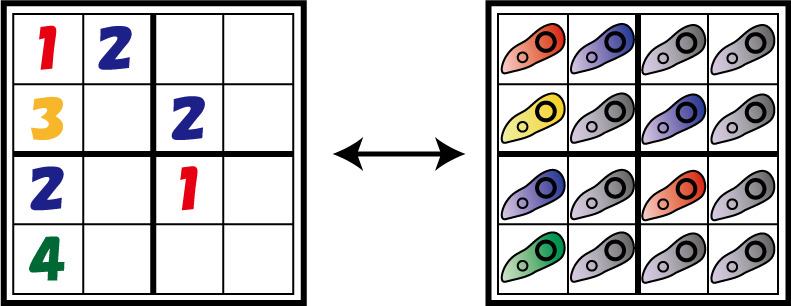Team:UT-Tokyo/Sudoku abstract
From 2010.igem.org


Sudoku
Introduction Construct Lab note Result
Introduction
We're trying to make E.coli solve Sudoku puzzle. Human and Computers can solve Sudoku, of course. But E.coli, which is lower animal, solves sudoku in our project. It is very very interesting!
What is Sudoku?
Sudoku is a puzzle game with the objective of filling a 9x9 grid of cells with the numbers 1~9 without entering the same number in a column, row or “block (see figure).” A player is given a grid in which some of the cells are filled in from the beginning and must complete filling in the grid by entering the remaining numbers. The rules are simple, but some puzzles can get very difficult, and it attracts fans from all over the world. For simplicity, here we solve a 4x4 grid version. However, expanding on the same principles, our E. coli can theoretically solve larger grids, for example 9x9 grids.
Solving Sudoku with our E. coli
Now, we explain how to make E. coli solve Sudoku. First, we make 16 kinds E. coli corresponding to each cell. (図!) Our E. coli are in one of two states, which we designate “differentiated” or “undifferentiated.” There are four differentiated states corresponding to the numbers one to four. (図!) Differentiated E. coli have the ability to inform other bacteria what number they are, so that relevant bacteria do not differentiate into that number. Some E. coli are differentiated from the beginning. These bacteria set in action a chain of transmission events that result in the differentiation of bacteria corresponding to all 16 cells. These events take place in a flask which contains a co-culture of the 16 types of bacteria. Each of these 16 types interacts with detection bacteria on a plate which in turn inform the viewer the number the 16 cells have differentiated into with the use of fluorescent proteins.
Reference
MS2 1. 2.
Safety issue
We use new parts which are not registered as BioBrick parts. We don't intend to execute experiment which affect the environment or human body. We do experiment in the laboratory which safety is maintained and recombinant E.coli and virus which include new parts are not taken out of the laboratory.
 "
"


